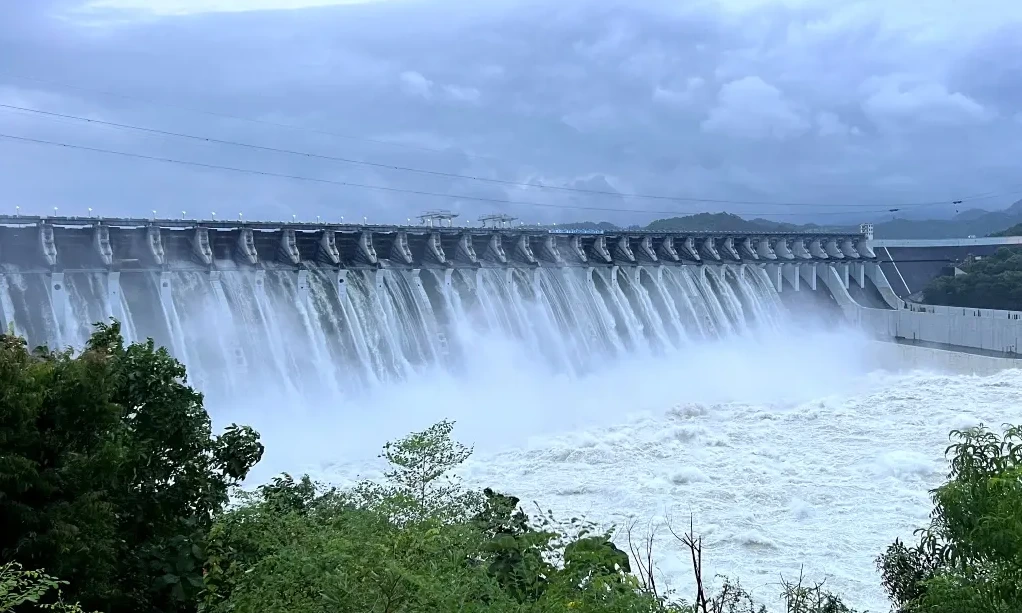The Sardar Sarovar Dam stands as one of India’s greatest feats of modern engineering, transforming the arid landscapes of Gujarat and surrounding states through its immense capacity for irrigation and hydroelectric power generation. Located near Kevadiya in Gujarat, this massive gravity dam is constructed across the Narmada River—India’s fifth largest river.
Key Specifications and Features
- Type: Concrete gravity dam
- Length: 1210 meters
- Maximum Height: 163 meters from the deepest foundation
- Normal Elevation: 138.68 meters above river bed
- Reservoir Capacity: 0.58 million hectare-metres (live storage)
- Canal System: 460 km long main canal; world’s longest lined irrigation canal
- Spillway Capacity: 84,949 cumecs (30 lakh cusecs) with 30 radial gates for flood control
- Power Generation: Total capacity of 1,450 MW (River Bed Power House: 1,200 MW; Canal Head Power House: 250 MW)
- Turbines Used: Francis and Kaplan types
The foundation stone of the Sardar Sarovar Dam was laid by Prime Minister Jawaharlal Nehru in April 1961, inspired by Sardar Vallabhbhai Patel’s vision of using water resources for development. Construction commenced in the late 20th century and faced several legal, environmental, and social hurdles before its final inauguration in 2017 by Prime Minister Narendra Modi.
Multipurpose Benefits
The dam was built to serve multiple needs:
- Irrigation: Provides lifeline water to 1.9 million hectares in drought-prone regions of Gujarat, Rajasthan, Madhya Pradesh, and Maharashtra.
- Drinking Water Supply: Delivers potable water to thousands of villages and major cities suffering from chronic water shortages.
- Hydroelectric Power: Installed capacity of 1450 MW from two power plants, using both Francis and Kaplan turbines.
- Flood Protection: Provides flood mitigation to extensive riverine areas.
- Tourism: Major attraction due to its size and proximity to the Statue of Unity.
Technological and Environmental Highlights
- Features advanced seismic monitoring instruments for safety in an earthquake-prone region.
- Considers environmental impact through regulated water flow, though the project has seen debate over displacement and resettlement of local communities.
- Designed with robust flood control mechanisms to mitigate downstream risks during monsoon season.
Visitor Information and Tourism
Today, the Sardar Sarovar Dam is also a major national and international tourist destination:
- Located close to the world-famous Statue of Unity, honoring Sardar Patel.
- Guided tours are available, with educational exhibits about the dam’s operation and history.
- Easily accessible from Vadodara and Ahmedabad, with well-developed infrastructure for visitors.
MCQs
1. The Sardar Sarovar Dam is constructed on which river?
a) Krishna
b) Bhagirathi
c) Narmada
d) Mahanadi
Answer: c) Narmada
2. In which state is the Sardar Sarovar Dam located?
a) Maharashtra
b) Gujarat
c) Uttar Pradesh
d) Rajasthan
Answer: b) Gujarat
3. Which states benefit directly from the Sardar Sarovar Dam’s water and power supply?
a) Gujarat, Rajasthan, Maharashtra, and Madhya Pradesh
b) Gujarat, Uttar Pradesh, Tamil Nadu, and Kerala
c) Maharashtra, Karnataka, Punjab, and Haryana
d) Rajasthan, Odisha, West Bengal, and Assam
Answer: a) Gujarat, Rajasthan, Maharashtra, and Madhya Pradesh
4. What type of dam is Sardar Sarovar?
a) Arch dam
b) Earthen dam
c) Concrete gravity dam
d) Masonry dam
Answer: c) Concrete gravity dam
5. What is the primary purpose of the Sardar Sarovar Dam?
a) Flood control only
b) Generation of nuclear energy
c) Irrigation, drinking water, and hydropower
d) Recreation and tourism
Answer: c) Irrigation, drinking water, and hydropower
6. Which famous monument is located close to the Sardar Sarovar Dam?
a) Gateway of India
b) Statue of Unity
c) Sun Temple, Konark
d) Lotus Temple
Answer: b) Statue of Unity
Frequently Asked Questions (FAQs)
Q. Why is the Sardar Sarovar Dam famous?
It is the second-largest dam by volume of concrete used in the world and features the world’s longest irrigation canal network.
Q. Which states benefit from the dam?
Gujarat, Madhya Pradesh, Maharashtra, and Rajasthan all gain from its irrigation, power, and water supply capabilities.
Q. Are there controversies?
Yes, mainly regarding environmental impact and rehabilitation of displaced populations, but large-scale resettlement schemes and court interventions have helped manage these issues.
The Sardar Sarovar Dam is a symbol of modern India’s resolve to overcome adversity through technological innovation, balancing resource development with sustainability. It continues to play a vital role in agriculture, energy generation, and water supply for millions of Indians.

